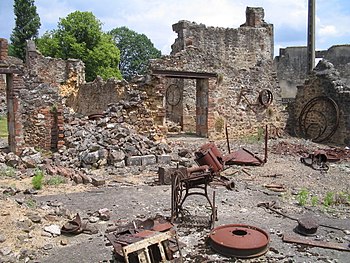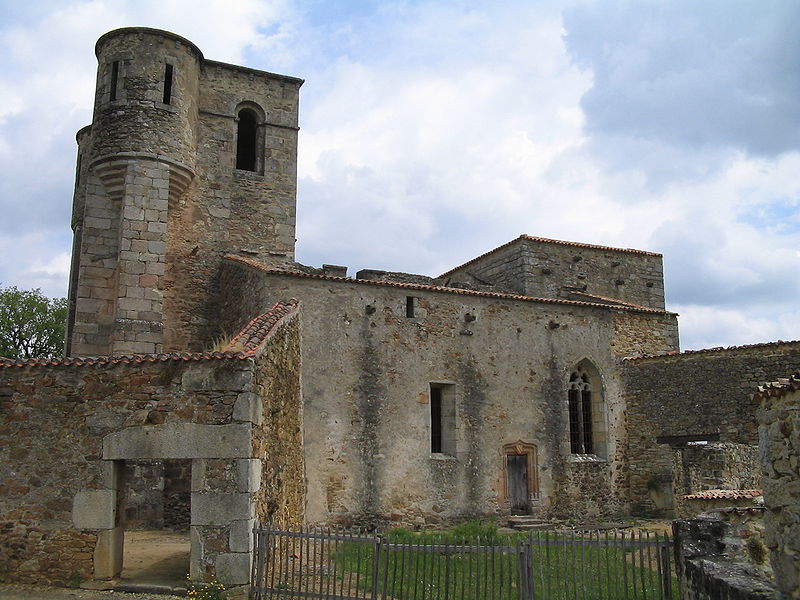Looking back into my research files today to bring you the story behind one of the pivotal events in The Alice Network. (Don’t worry–no spoilers here if you haven’t read TAN yet.)
In central France, a few miles from Limoges, lies a ghost town called Oradour-sur-Glane. At first glance it looks simply abandoned—empty houses, tram lines waiting for trams no longer running, a rusting car abandoned at an empty fairground—but signs of tragedy are soon evident at a second look. Roadside walls are pocked with bullet holes, stone houses are scorched by fire marks, the church roof is gone from some massive explosion. An abandoned clock lies fire-melted in the street, forever frozen at four in the afternoon. No one has inhabited Oradour-sur-Glane since June 10, 1944.

Wrecked hardware–bicycles, a sewing machine, etc.–in Oradour-sur Glane. Public domain image courtesy of Dennis Nilsson
On that day—not long after the invasion of Normandy, as German forces rushed to meet the Allied advance—a regiment of the 2nd SS-Panzer Division Das Reich surrounded the village of Oradour-sur-Glane. The men of the village were quickly rounded up, then herded into a variety of surrounding barns and garages as the women and children were confined to the local church.
At four in the afternoon, the killing began.
A gas bomb was placed in the church and ignited. When the resulting fire and smoke failed to suffocate the women and children inside, the SS mowed them down with machine guns. The men were systematically shot in their barns and rabbit hutches, the wounded and dying locked inside as the buildings were set alight. Only a handful survived: five men managed to struggle free of a burning barn and escape into the fields, a family of children survived by hiding in an empty hotel, and a boy of eight played dead until he could crawl to safety. There was only one survivor from the church, a middle-aged woman whose daughters and granddaughter died in the inferno, yet who managed to climb out a high altar window and hide in a nearby garden, despite being shot five times.

The church in Oradour-sur-Glane where the women and children died.
Public domain image courtesy of Dennis Nilsson
That night, champagne corks popped in the ruined town. Soon after, the Germans moved north. The town remained empty, combed over by stunned neighbors and survivors. After the war it was decreed that the town of Oradour-sur-Glane be rebuilt nearby, but that the original site stand as a memorial to the massacred dead . . . and ever since, it has attracted horrified visitors and horrified questions. Chief among them, as with any seemingly senseless massacre: why?
The Germans were certainly no strangers to atrocities, but why was tiny, remote Oradour-sur-Glane exterminated with such sweeping finality? The Sturmbannfuhrer who commanded the division so thoroughly exceeded his orders in massacring the villagers that even his own superiors were taken aback; he might have been court-martialed had he not died in action a few weeks after the massacre. So the question remains: why?
French Resistance activity was suspected in the area. The day before the massacre, reports filtered in from the Milice (French informers) that a German officer had been kidnapped by Resistance members, possibly taken to Oradour-sur-Glane, and executed. The division’s Sturmbannfuhrer seems to have assumed the murdered officer was a missing friend of his, and requested permission to mount a pursuit, take hostages, and force the Resistance to release the man or his body. But he made no attempt at recovery or at hostage-taking, simply unleashing an orgy of revenge for his murdered friend.
That’s one possibility, but others abound. It’s possible that the reprisal was intended for nearby Oradour-sur-Vayres, a larger town where rebellious activity was more plausibly located. It’s possible that Oradour-sur-Glane was chosen for extermination simply as a sweeping example to quiet an uneasy region. And there are theories that the massacre was at least partially accidental; that the village church had been storing explosives for the Resistance, and the explosion resulted from machine gun fire igniting the hidden cache.
In the end we will probably never know the reasons why death descended on Oradour-sur-Glane on June 10, 1944. I have woven my own story around it in The Alice Network; the story of the still-abandoned ghost town outside Limoges has fascinated and haunted me from the moment I saw the photographs of its burned houses, melted clocks, and cars parked at curbs as if still waiting for drivers who never returned. Many lives were silenced that day in Oradour-sur-Glane, but their echoes speak loud and clear in the ghost town they once called home.
For more information about the Oradour-sur-Glane tragedy, including timeline, aftermath, and hundreds of photographs, I recommend this excellent website. I found it invaluable when writing the scene in The Alice Network which takes place on those haunted streets.

Amazon | iTunes | Barnes & Noble | Kobo







